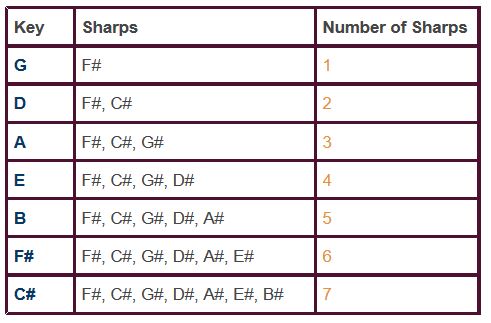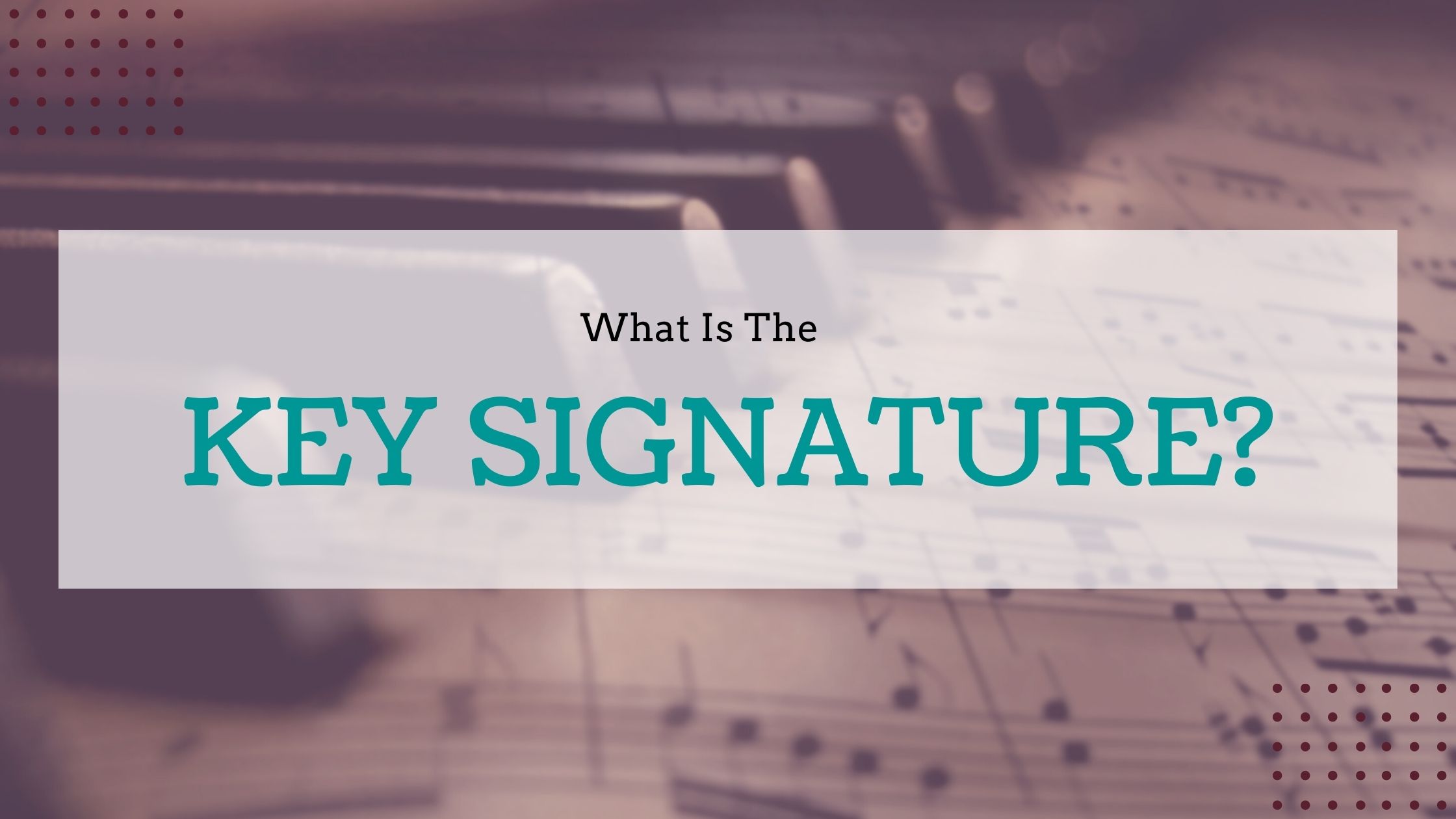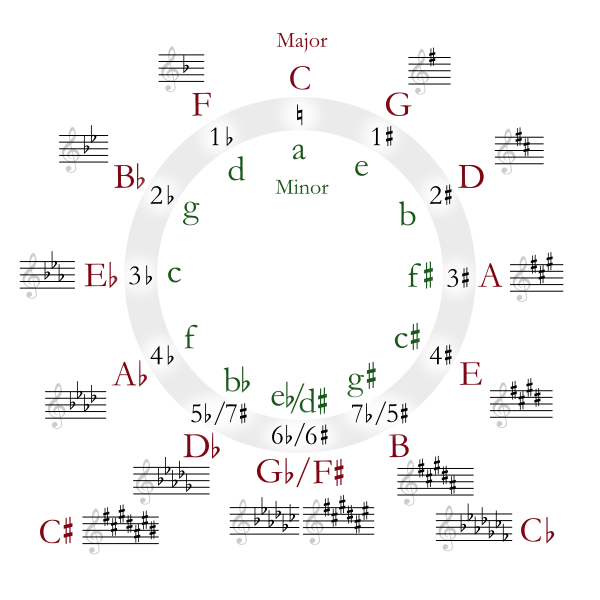Need To Memorize Key Signatures?
It's not too difficult to memorize key signatures. The way I memorized
them was by using
sayings. With key signatures, there are 3 things you need
to memorize.
1. The order of the sharps
and flats
2. The order of the keys
(and how many sharps or flats they have)
3. Where to put them on the
staff
Order of Sharps and Flats
First is the order of sharps. You can memorize the order of sharps with this saying: Father Charles Goes Down And Ends Battle. The first letter of each word stands for a sharp.
To memorize the order of the flats you can make up a saying if you want. What I do is remember that the first 4 spell a word: BEAD. After that I remember that the ones that follow are GCF.
If you have trouble remembering the last 3, remember that the next flat is always 4 notes higher than the last one.
Order of the
Keys
Next in trying to memorize key signatures is memorizing the order of
the
keys. You know that the key of C has no sharps or flats. From this key
you can figure out the order of the rest.
First the sharps. You can memorize
the order of the sharps by counting up 5 notes
from the last one. For example, the key with one sharp is G. You can
find it by going C-D-E-F-G. The next one is is D - 5 notes up from G.
You may have heard this being called the "Circle of 5ths."
To memorize the key signatures with flats
in them, you can count
up 4 notes.
There is also another way. The key of F has only one flat - Bb. The key
with 2 flats is Bb. Bb has 2 flats, Bb and Eb and so the next key in
the order is Eb. Whatever
the last flat is, it's the next key in the order.
Where To Put Them on the Staff
The final part of trying to memorize key signatures is where to put
them on the staff. It's not very hard. For the sharps in the treble
clef, you start on the top
line of the staff. Follow the pattern of up - down
- up - down. The only exception is A. It should look like this:

Bass clef sharps start on F and then follow the same pattern of up - down - up - down.

The flats have the opposite pattern. They start on B and go down - up - down - up. It looks like this.


Those are my tips to help you to memorize key signatures. If you need
to know anymore about key signatures, try going back and checking out
the main key
signatures page.
Return from Memorize
Key Signatures
to Piano
Lessons Info Homepage.
FAQ for Memorizing Key Signatures
1. What is a key signature in music?
1. What is a key signature in music?
A key signature is a set of sharp or flat symbols placed together on the staff at the beginning of a piece of music, indicating the key in which the music is to be played.
2. Why is it important to memorize key signatures?
2. Why is it important to memorize key signatures?
Memorizing key signatures is important because it helps you quickly identify the key of a piece of music and the notes you'll play most often. This can help you understand the structure of the piece and play it more accurately.
3. How can I memorize key signatures?
3. How can I memorize key signatures?
There are a few methods for memorizing key signatures. One common method is the "Circle of Fifths," which arranges all the major and minor keys in a circle based on their relationship to each other. Another method is to memorize the number of sharps or flats in each key and their order of appearance.
4. What is the Circle of Fifths and how can it help me memorize key signatures?
4. What is the Circle of Fifths and how can it help me memorize key signatures?
The Circle of Fifths is a visual representation of the relationships among the 12 tones of the chromatic scale. It is a useful tool for understanding and memorizing key signatures as adjacent keys on the circle have one note difference.
5. Is there a particular order in which sharps and flats appear in key signatures?
5. Is there a particular order in which sharps and flats appear in key signatures?
Yes, sharps and flats always appear in a specific order in key signatures. The order for sharps is F-C-G-D-A-E-B, and the order for flats is the reverse: B-E-A-D-G-C-F.
6. How can I practice key signatures?
6. How can I practice key signatures?
One way to practice key signatures is to write out the Circle of Fifths and fill in the number of sharps or flats for each key. Another is to practice scales in different keys, paying attention to the key signature for each one.
7. Are there any shortcuts to memorizing key signatures?
7. Are there any shortcuts to memorizing key signatures?
There are a few shortcuts you can use. For example, in a key with sharps, the key is one half step up from the last sharp. In a key with flats, the second to last flat is the key.
8. How long does it take to memorize all key signatures?
8. How long does it take to memorize all key signatures?
The time it takes to memorize all key signatures can vary depending on factors like your previous musical experience and how often you practice. However, with regular practice, most people can memorize all key signatures within a few weeks.
9. What's the difference between major and minor key signatures?
9. What's the difference between major and minor key signatures?
Major and minor key signatures can have the same number of sharps or flats, but they refer to different keys and scales. For example, the key signature with one sharp could be either G major or E minor.
10. Can I play music without knowing the key signature?
10. Can I play music without knowing the key signature?
While it's possible to play music without knowing the key signature, it's much easier and more accurate to play when you do. Knowing the key signature can help you anticipate which notes will be sharped or flatted throughout the piece.
Recent Articles
-
Piano Notes Chart
Nov 20, 23 10:21 PM
Find a piano notes chart for treble clef and bass clef notes as well as the different types of notes. -
D Chord on Piano + Diagram, How To & Theory
Oct 24, 23 12:20 AM
Learn how to play the D chord on piano with diagram, fingering, D/A, D/F# and a theory explainer. -
Diminished Piano Chords: Chart & How to Make Them
Oct 09, 23 09:23 PM
Learn the different diminished piano chords and how to make them. Here you'll find both a diminished chord chart and an explanation.
- Home
- Key Signatures
- Memorize Key Signatures












